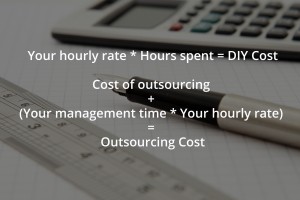 For many small business owners and startups, everything is DIY. But new ways of thinking about outsourcing and DIY are saving companies both time and money, and the outcomes are better than ever before.
For many small business owners and startups, everything is DIY. But new ways of thinking about outsourcing and DIY are saving companies both time and money, and the outcomes are better than ever before.
Think about it this way. You probably don’t cut your own hair or sew your own clothes, and you outsource the work of grocery shopping, cooking and cleaning dishes every time you eat at a restaurant. So if your business is great at cleaning carpets, why spend your precious time and energy on something like tax preparation? Similarly, if you run a dental office, why spend time repairing your own plumbing or creating software to manage your accounts?
It seems like straightforward reasoning, but there’s another side of the coin. You can find blogs and advice on how to DIY for almost everything, whether it’s managing your marketing, setting up employee benefits or sales and lead generation.
How to Calculate Total Costs
So how do you decide what to outsource and what to do yourself? Based on our experience with business of all sizes and in multiple countries, we recommend reducing the question to a simple formula.
First, figure out how much your time is worth. If you charge your customers $100 an hour, for example, start there. If you don’t already have an idea, calculate your monthly income and divide it by the number of hours you work in a month. Next, think about how long the task will take you. Don’t forget about any time you will need to educate yourself about the task. Learning is great, but don’t forget that you are spending money to learn. Now, come up with a total cost for your time.
Next, calculate the cost of outsourcing a given service by getting a few bids. You may have to learn enough about the service and the outsourcing options available in order to make a good judgment, and you may need to spend time managing the project regardless, so don’t forget to add that in. Pay attention to the hourly rate charged by the contractor or service, but for this calculation use a total project cost. Finally, compare the figures.
Decide Based on the Numbers, Mostly
Now that you have the numbers, making a decision will be easier. In most situations, it makes sense to make the less costly decision. However, there are a few other things to keep in mind.
Are There Legal Requirements to Fulfill?
If your project has to do with legal, accounting, HR or investment issues, you may need professional expertise that would be simply impossible to gain while you try to run a business. If you don’t get the experienced help you need from an outside source, you could open yourself up to a great deal of risk. Even if you aren’t sued or fined for doing something wrong, you may eventually have to pay for a true professional to come in and fix the problem.
Could an Expert Do It Better?
If your DIY and outsourcing costs are close, it can be tempting to fall into the mindset that DIY is always better because it makes your processes proprietary and leaves you in control. Be cautious of this kind of thinking, because sometimes people who do a given task day in and day out will do higher quality work than you ever could. And as for being in control, you could be overestimating risk and making the mistake of thinking things are better just because you did them, not because they actually are. Higher quality for relatively low cost might come into play in the areas of graphic design, marketing, social media or building your website.
Are You Taking Time from More Important Tasks?
This one goes all the way back to the economist Adam Smith, who many consider to be the father of modern capitalism. He talked about self-interest, specialization and the division of labor as the best way to increase skill and dexterity and, ultimately, boost production and grow the wealth of a nation.
The philosophical takeaway for today’s business owners is that you should spend most of your time working in your expertise rather than trying to do it all. Even if your cost to manage your own social media is less than you would pay for someone else to do it, what else could you be doing with that time? If you could be getting more customers or performing more jobs, be sure to take that into account. Put revenue first.
Focus on Your Core Competencies
We have seen many business owners stressed to the max, trying to do ten things at once and nevertheless letting important matters slip through the cracks. Unfortunately, we’ve even seen many businesses fail for this reason. We don’t recommend filling your own cavities in your personal life, and we don’t recommend spending time outside your expertise in business. Your path to success is paved with your company’s unique value proposition, not your ability to wear 10 hats.

